Trapped inside during Covid-19? Jump to Virtual Museum Experiences...
Also see: 15 Virtual Travel Experiences | Books to Inspire Wanderlust | Virtual Travel Playist - Songs From Around the World
Question: What do staplers, candles, and ear rings have in common?
Answer: They’re among the items on display at a wacky and wonderful museum in California which claims that it has the largest collection in the world devoted to a single fruit.
The International Banana Museum is one of many places around the globe where people may check out exhibits that range from the unusual to the unique, and from serious to hilarious.
For starters, the Banana Museum touts itself with a pun, proclaiming itself to be “The most aPEELing destination on the planet.” Among more than 20,000 items are bananas made of glass, plastic, stone, metal, alabaster, wood and even jade. The list of articles shaped like, decorated with or reminiscent of bananas is long and, at times, surprising. It includes compasses and cookie jars, socks and squirt guns, dishes and dolls.
There’s also a Banana Bar that serves – surprise! -- banana shakes, ice cream floats and other treats. For more information log onto internationalbananamuseum.com.
Speaking of flavors, have you ever tasted mustard enhanced with chocolate, blue cheese or tequila? If not, you've probably never been to the National Mustard Museum at Middleton, Wisconsin.
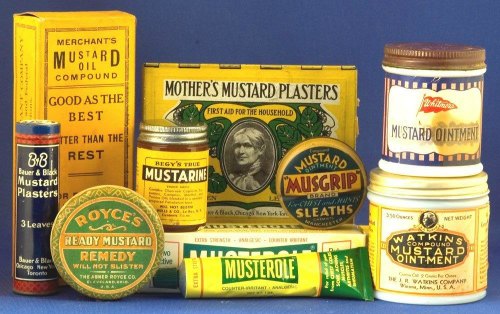
Visitors are introduced to some 5,400 mustards from all 50 U.S. states and more than 70 countries. They learn about uses of mustard as medicine, and have the opportunity to sample hundreds of mustards at a tasting bar.
Staff members sing "Roll out the Mustard" and recite passages from Shakespeare which refer to the “King of Condiments.” No wonder the museum is listed on the National Registry of Hysterical Places. For more information, log onto mustardmuseum.com.
These are but two examples of offbeat museums in the United States that attract visitors seeking something different. Other countries around the world also have their own out-of-the-ordinary offerings.
For example, folks in England who like to delve into the occult may scare up some fun at the Museum of Witchcraft and Magic in Cornwall. There they can explore the history of magical practices from ancient times to the present. Images on a pewter goblet recall legends of a goddess-like figure who was a magical enchantress and megalomaniacal witch.
Among the rather gruesome contents of a Haitian “magical box” are a dried toad and rabbit’s head, and a figure with a bird’s skull which is bound human hair. Among occasional events offered at the museum are plays, magic walks and, of course, special Halloween events.
It takes no magic to figure out what’s on display at the Dog Collar Museum housed in a castle in Kent, England. The canine neckwear spans five centuries from Medieval to Victorian times.
Thick iron collars covered with sharp spikes were used during the 15th-to-17th centuries when Europe’s forests teemed with dangerous predators that were happy to rip out the throat of any hunting dog that entered their territory. They contrast with delicate, ornate canine neckwear made of silver, fine leather and velvet, sometimes decorated with the coat of arms of royal owners.
A sense of humor prompted the engraving on an 18th-century brass collar which states: “I am Mr. Pratt’s dog. Whose dog are you?”
Animals in a different form grace the somewhat creepy Museum of Osteology, which brings to life (pun intended) the branch of anatomy which deals with bones. The museum branch in Oklahoma is home to nearly 300 skeletons that range in size from tiny mice to a 40-foot-long humpback whale.
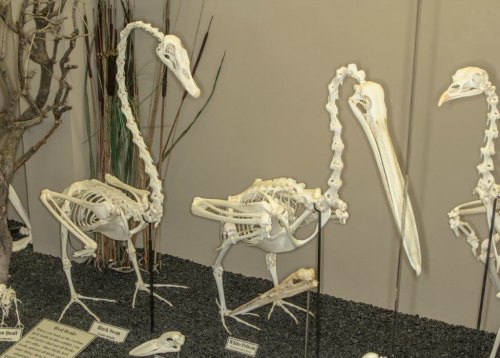
A sister museum in Florida is aptly named Skeletons: Animals Unveiled. The residents of that establishment strike imaginative poses in eerily lifelike dioramas.
Much smaller life forms are under the microscope (so to speak) at the Meguro Parasitological Museum in Tokyo. In addition to operating as a research and educational facility, that establishment maintains a collection of some 60,000 parasite specimens, some of which are on public display. The themes of the exhibits are the diversity of parasites and parasites that affect humans, including those which can be transmitted from animals.
Visitors with a true penchant for parasites may wish to stop by the gift shop to browse among T-shirts, cloth shopping bags, magnets and other items decorated with – you guessed it! – images of parasites.
From parasites to potties seems like a natural progression so next we’ll visit the Sulabh International Museum of Toilets in New Delhi, India. It details the evolution of toilets from 2,500 BC to the present. Exhibits include ornately carved and painted urinals and commodes, and introduce viewers to gold and silver toilet pots that were used by the Roman emperors and a very early flush pot which was devised in 1596 by a courtier of Queen Elizabeth I.

In a nod to gentility, the collection displays poems related to toilets and their use. Furthermore, this museum is not mere flush-in-the-pan. It makes the rather grandiose claim that among its objectives are providing information to researchers, manufacturers and sanitation policy makers.
People who wish to view the sculptures in two other museums need to swim in or float above a different kind of water. The Museo Subacuatico de Arte near Cancun, Mexico and the Museo Atlantico in the sea off the Canary Islands combine art with science. Underwater sculptures at both locations delight those who admire them while diving, snorkeling or viewing them from a boat at the same time that they create artificial reefs which help to protect the marine environment.
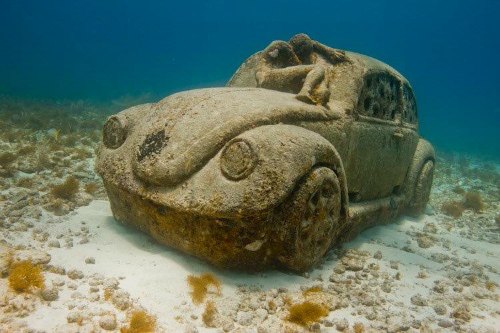
The Mexican underwater gallery includes more than 500 statues submerged between 10 and 20 feet at three locations. Among the works are the Dream Collector, the Promise, Thing Blue (a Volkswagen automobile) and six businessmen with their heads buried in the sand.
Silent Evolution, the major installation, includes some 450 sculptures which show people interacting with their environment in both positive and negative ways. Each statue resembles a member of the local village where the sculptor lives including a young boy, a nun and a fisherman.
The Museo Atlantico is a work in progress. So far, six groups of figures have been submerged 50 feet below the surface, and like their Mexican cousins they too resemble residents of the area.

The sculptures vary from serious themes, like an image which refers to the current refugee crisis, to lighthearted scenes including a group of children in small brass boats and a couple taking a selfie.
For more information log onto musamexico.org and cactlanzarote.com/en/cact/mu.
Art follows a different path at a museum which brags that it’s the only one “dedicated to the collection, preservation, exhibition and celebration of bad art.” The stated goal of the Museum of Bad Art in Boston is “to bring the worst of art to the widest of audiences.”

Each piece in the collection is presented with an appropriate description. For example, the Blue Mushroom Man has toadstools sprouting out of the top of his head, while the aptly named Woman Riding Crustacean depicts “a blow-up doll riding a giant lobster.” If this appeals to your artistic fancy, you may log onto museumofbadart.org for more information.
Mother Nature gets into the art scene at the Messner Mountain Museum, actually a network of six locations in Italy that combine some of the most spectacular scenery in Europe with explorations of various themes related to their settings.
The focus of one museum is mountain myths while another tells the story of mountain people. The building perched atop 7,500-foot-tall Mount Kronplatz is dedicated to traditional mountain climbing, while the Museum in the Clouds on Monte Rite with its glass-enclosed pavilion is sensational for the panoramic views alone. Adding to its appeal is a collection of paintings of the Dolomite Mountains over two centuries.
If this short list of out-of-the-ordinary museums leaves you wanting, fear not. An A (Anaesthesia) to Z (Zeppelin) choice of museums which stretches the usual meaning of that word awaits discovery around the world and, perhaps, not far from where you live.
Virtual Museum Experiences
In today's world, impacted by Covid-19, virtual travel experiences are leading the charge for the wanderlust-affected
Here are some unique virtual museums to whisk you away while in your living room:
It’s not often that someone about to enter a museum first dons snorkel equipment or Scuba gear. Or, if they’re a bit squeamish about going into, or under, the water opts to view the exhibits through the underside of a glass-bottom boat.
If that seems a bit unusual, so are the collections at a number of museums around the world which go beyond – in some cases, way beyond -- the usual art, historical items and other paraphernalia often associated with those institutions.
Eschewing the interesting but at times staid assemblages of items expected, and found, at most establishments, these admitted outliers pride themselves in introducing visitors to items and their stories which can be as unlikely as they are likeable, as fun as they are fascinating.
Adding to their appeal at the present time are opportunities to enjoy what they offer with no more effort on your part than it takes to let your computer mouse do the walking.
From image galleries to slideshows to YouTube presentations, virtual visits to these museums offer fun, fancy and even some food for thought.
The Cancun Underwater Museum (Museo Subacuatico de Arte) is a perfect example of this dual personality. Those who swim in, paddle over or ride in a boat through the Mexican National Marine Park are treated to a true submerged extravaganza. Some 500 sculptures are divided into three galleries which attract a variety of marine life along with their human admirers.
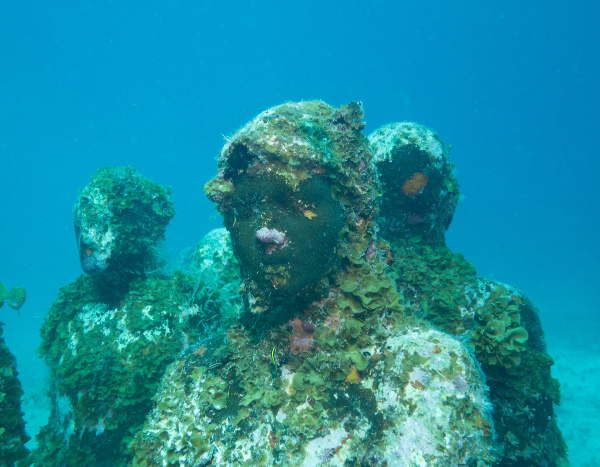
Most of the works were produced by a renowned British sculptor. And others by a handful of Mexican artists. Some of the human faces depict residents of Cancun and other Mexican cities.
Along with their artistic appeal, the statuary plays an environmentally friendly role. The sculptures are made of marine-friendly materials which over time is morphing into a stunning reef. The goal is to preserve the nearby coral shoals by providing an alternative destination for divers. (For more information and to view images of some of the fantastic sculptures, log onto musamexico.org)
Each year, millions of people visit museums around the world which are located on dry land to admire great works by painters, sculptors and other creators of fine art whose names, and masterpieces, will live forever. Fewer enjoy viewing “the best bad art” which ranges “from the works of talented artists that have gone awry to works of exuberant, although crude, execution by artists hardly in control of the brush.”
The Museum of Bad Art in Somerville, Massachusetts is “the world’s only museum dedicated to the collection, preservation, exhibition and celebration of bad art in all its forms.” It lives up to its stated mission – “To bring the worst of art to the widest of audiences” – in galleries devoted to topics like Poor Traits and In the Nood.
The painting titled “Giraffe at the Beach” shows the animal walking on, rather than by, the sea. “The Pout” depicts an anatomically incorrect child with a very sour look on her face. They’re among more than 700 pieces owned by the museum which, according to its own description, are set apart “in one way or another from the merely incompetent.” To view a sampling of the collection log onto museumofbadart.com.
Photography is another art form and taking “selfies’ is among its most recent manifestations. No surprise, then, that there’s a museum devoted to that form of expression, or that it’s located in Hollywood. When the interactive exhibits are open to the public visitors may play king on a selfie throne, relax in a virtual emoji pool and walk the red carpet to pick up their Oscar. In the meantime, the website allows viewers to enjoy a sampling of the selfie opportunities. (museumofselfies.com)
If Hollywood is the land of dreams, a museum in Sweden is devoted to aspirations that crashed and burned. The stories of more than 70 products and services that had spectacular failures include plastic bicycles which were too expensive and broke too easily, an electric facial toning mask and – flop of all flops – the Ford Edsel. A YouTube presentation is among presentations describing these and other fiascos. (museumoffailure.com)
Broken relationships rather than shattered items are explored at another unique museum in Zagreb, Croatia through objects that include stiletto shoes, a vase and other objects which represent the end of friendships, love affairs and marriages.

The women's footwear was taken by her lover as a memento of their long, but unconsummated, connection. The young woman who donated a Frisbee to the museum received it from her boyfriend on the second anniversary of their meeting, and took it as a sign that she was being tossed aside. (brokenships.com)
Paranormal relationships, palmistry and curses are among eerie topics included in the history of magical practices in Britain. Among artifacts at a museum in Cornwall believed by some to possess paranormal powers are a dried rabbit head, bird skull and puppet used to cast spells on people. Website viewers may scan through pictures of the collection and view short videos. (museumofwitchcraftandmagic.com)
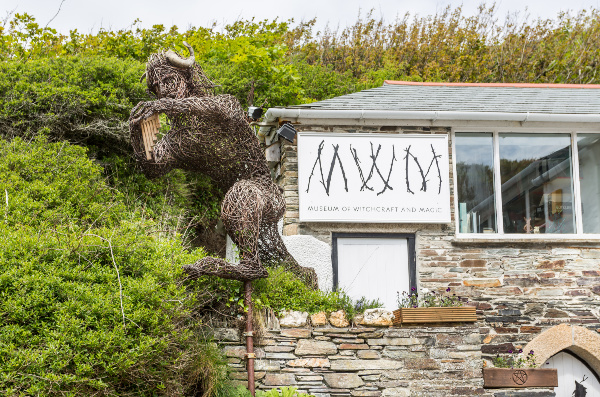
Food also is a frequent focus of exhibits, which include some surprising provisions. If you don’t think there’s enough variety to stock an entire building with items related to bananas, think again. From candy to compasses, pipes to perfume, more than 25,000 products shaped in the form of, tasting like and otherwise related to that popular fruit fill a gallery in California.
When the museum is open, visitors may enjoy banana-flavored ice cream, shakes and other treats. Until then, virtual visitors must make do with a slide show. (internationalbananamuseum.com)
Another yellow food is honored in Middleton, Wisconsin, where mustard is honored as the King of Condiments. Among surprises which visitors learn are that some people bathe in a mustard bath to soak away tension and fatigue, while others use it to flavor spice cake. A visit to the website offers recipes, photos and fun facts. (mustadmuseum.com)
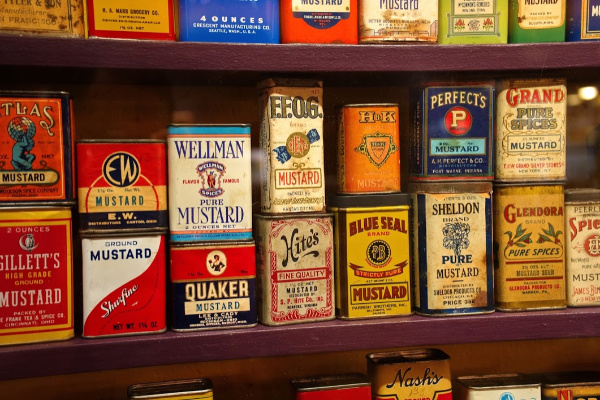
This is but a brief sampling of countless below-the-radar museums around the world that make up in offbeat appeal and quirky collections what they may lack in fame. Whatever your hobbies and interests, it’s possible – perhaps even likely -- that you can make a simulated visit to one or more which will provide a welcome experience and diversion.


